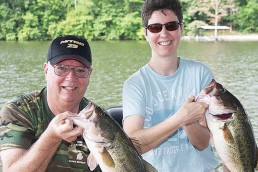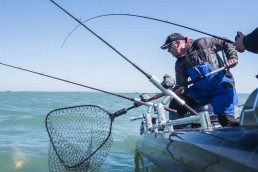Alternatives for the Dog Days
SHARE THIS POST
Most fishermen braving the heat this summer have been hovering over the deep ledges hoping for a little current to activate the fish and a little breeze to cool the brow. The majority of them are probably lobbing around plastic worms the size of garter snakes. These 10- to 12-inch monsters have become a sort of a summer tradition on Kentucky Lake. And although they work pretty well in summer, the fact everyone is using them and so many fish have seen them has to detract from their productivity. Familiarity does breed contempt among the scaly fraternity.
But there are alternative lures for the ledges. Some of them not only work as well as the plastic snakes, but they may work even better because most fish have never seen them. One of the least known dog-days alternatives being used by guides and professional fishermen is a short-arm, single-spin spinnerbait.
I doubt there’s a fisherman out there who doesn’t have some spinnerbaits handy, but I suspect most will have to search their supplies to find a heavy, short-arm model with just one blade. These aren’t as versatile as other models; they’re made specifically to hop, drop and pop in the ebony depths.
If you have any heavy, short arms at all, it’s probably a black one that you bought to fish at night. You can use that during the day too, but my favorite is a 3/4-ounce white or chartreuse with a gold Colorado blade. Many like a silver blade when it’s bright and a gold blade when it’s overcast, but for my way of thinking, it’s always pretty dark in our lakes below the 15-foot level.
You can go as heavy as 1 ounce or as light as 1/2 and use just about any color. The important thing with this technique is the thump of the blade and the rather unique way of presenting the bait.
Forget that you’ve got a spinnerbait attached—think jig. Hop it, drop it or pop it like a jig. The most basic way is to let it settle to the bottom, lift the rod tip just enough to get it moving, and then let it drop again. This is a highly effective method, but it does get you hung up occasionally.
Many like to fish a jig or a short-arm spinnerbait for that matter, and pop it hard the instant it touches down. They flip the rod tip up with a quick wrist action (almost like setting the hook) the instant the bait hits the bottom. Then they let it fall on a slack line. I don’t really prefer to fish a jig this way most of time, but a little milder version of this technique is my favorite way to present a deep spinnerbait.
Are you enjoying this post?
You can be among the first to get the latest info on where to go, what to use and how to use it!
The instant it touches down, I pop it quickly, but only about half as hard as I might to set the hook. Then, I let it fall on a slack line, lowering the rod tip slowly and taking up just enough slack to stay in contact with the bait so that it falls as vertically as possible.
Similar to a jig, most of your strikes are going to come on the fall, so you need to pay attention to the line and set the hook at the slightest twitch or bump. Sometimes the line just goes slack. But when in doubt, set the hook.
With this retrieve—I call a “half-pop”—the bait gets hung up less, and sometimes I’ll hook a fish that I didn’t realize had the bait. Big bass often just close their mouths around a bait without moving, and the line simply goes slack just like it does when the bait hits the bottom. By half-popping it the instant it goes slack, I’m often pleasantly surprised.
But the main reason the half-pop works so well is the same reason this bait works in the first place—the action of short-arm spinnerbaits entice reaction strikes from inactive or well-fed fish that grab the thing because they just can’t help it. A half-pop gets the blade spinning and thumping with a quick movement that demands their attention. When it falls, spinning and thumping slowly in front of their noses, an automatic reaction, which is a well-honed predatory instinct they’ve developed to keep them alive for so long, just takes over. I’ve caught a lot of good-sized fish with this method that were already so full of food they looked like they were pregnant.
Fishing during the dog days is notoriously slow primarily because of the warmer waters and natural forage is most abundant, so to get them to take our “fakes,” we’ve got to appeal to their instincts that go beyond their hunger. Heavy, short-arm, single-blade spinnerbaits hopped, dropped or popped along the ledges do just that.
For decades, Kruger has been communicating the outdoor experience for over four decades. He has worked as a full-time guide for trout on the North Fork, for crappies and bass on Kentucky Lake and for smallmouths on the Current River. He has served as editor of three outdoor magazines, and owns a patent on a fly/lure called the Desperate Diver.
MWO
SHARE THIS POST
Did you enjoy this post?
You can be among the first to get the latest info on where to go, what to use and how to use it!
Ron Kruger
Ron Kruger has been communicating the outdoor experience for more than four decades. He has worked as a full-time guide for trout on the North Fork, for crappies and bass on Kentucky Lake and for smallmouths on the Current River. He has served as editor of three outdoor magazines, and owns a patent on a fly/lure called the Desperate Diver.



